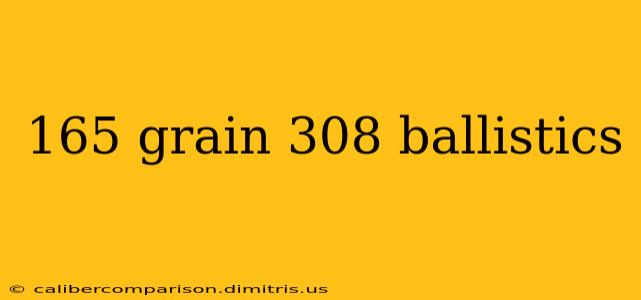The .308 Winchester, a cartridge renowned for its versatility and accuracy, finds a sweet spot with 165-grain projectiles. This weight class offers a compelling balance of downrange energy, trajectory, and recoil manageability, making it a popular choice for a wide array of applications. This article delves into the ballistics of 165-grain .308 ammunition, exploring its performance characteristics and suitability for various shooting disciplines.
Understanding 165 Grain .308 Ballistics
165-grain .308 bullets generally fall into a few categories: Boat-tail bullets designed for long-range accuracy, Full metal jacket (FMJ) rounds suitable for target practice and hunting, and even specialized hunting rounds with expanding or controlled-expansion designs. The specific ballistic characteristics—velocity, energy, trajectory—will vary considerably depending on the bullet's construction, the powder load, and the firearm used.
Key Ballistic Factors to Consider:
- Muzzle Velocity: Expect muzzle velocities ranging from approximately 2600 to 2800 feet per second (fps), depending on the specific cartridge and firearm. Higher muzzle velocities generally translate to flatter trajectories and increased downrange energy.
- Muzzle Energy: Muzzle energy will typically fall within the 2700 to 3000 foot-pounds (ft-lbs) range, providing sufficient power for hunting medium-sized game.
- Trajectory: The 165-grain bullet offers a relatively flat trajectory compared to lighter or heavier projectiles. This makes it easier to compensate for bullet drop at longer ranges.
- Ballistic Coefficient (BC): The BC is a measure of how well a bullet overcomes air resistance. Higher BC bullets retain velocity better over longer distances, resulting in flatter trajectories and less wind drift. Boat-tail designs generally boast higher BCs.
- Recoil: While manageable, recoil is noticeable with 165-grain .308 ammunition. This is a factor to consider, especially for shooters new to the caliber or those sensitive to recoil.
Applications of 165 Grain .308 Ammunition
The versatility of the 165-grain .308 makes it suitable for various applications:
Hunting
The 165-grain bullet's energy and trajectory are well-suited for hunting medium-sized game such as deer, hogs, and antelope. Expanding bullets are preferred for hunting to ensure clean kills and minimize meat damage.
Long-Range Target Shooting
With its relatively flat trajectory and potential for high ballistic coefficients, the 165-grain bullet is a popular choice for long-range target shooting. Precision manufacturing and boat-tail designs are crucial for maximizing accuracy at extended distances.
Competition Shooting
In some precision rifle competitions, the 165-grain bullet's predictable ballistics can provide a competitive edge. Consistency is key, and selecting a high-quality, consistent ammunition load is critical.
Tactical Applications (Law Enforcement & Military)
While not the primary choice for close-quarters combat, the 165-grain bullet can be used in tactical situations where longer-range accuracy is required. FMJ bullets are typically preferred for these applications.
Factors Affecting Ballistic Performance
Beyond the bullet weight, several factors influence the ballistic performance of 165-grain .308 ammunition:
- Rifle Twist Rate: The rate of twist in the rifling of the barrel affects bullet stability. An improperly matched twist rate can lead to poor accuracy.
- Powder Charge: The amount of powder used significantly impacts muzzle velocity and energy.
- Bullet Construction: Bullet construction (e.g., full metal jacket, soft point, boat-tail) dramatically affects ballistic coefficient, trajectory, and expansion characteristics.
- Environmental Conditions: Wind speed, temperature, and altitude can all influence bullet trajectory.
Choosing the Right 165 Grain .308 Ammunition
Selecting the appropriate 165-grain .308 ammunition depends heavily on its intended use. Carefully consider the bullet construction, intended range, and your firearm's specifications before making a purchase. Consult online ballistic calculators and manufacturer specifications to predict trajectory and energy at different ranges. Always prioritize safety and responsible gun handling practices.
This information provides a comprehensive overview of 165 grain .308 ballistics. However, always refer to the manufacturer's data and conduct your own testing to determine optimal performance for your specific firearm and intended application. Remember to prioritize safety and responsible gun ownership.

